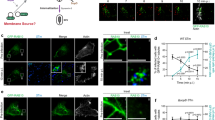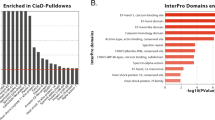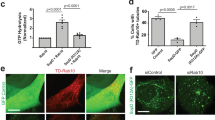Abstract
An essential feature of the bacterial pathogen Salmonella spp. is its ability to enter cells that are normally non-phagocytic, such as those of the intestinal epithelium1. The bacterium achieves entry by delivering effector proteins into the host-cell cytosol by means of a specialized protein-secretion system (termed type III), which causes reorganization of the cell's actin cytoskeleton and ruffling of its membrane2,3,4. One of the bacterial effectors that stimulates these cellular responses is SopE, which acts as a guanyl-nucleotide-exchange factor on Rho GTPase proteins such as Cdc42 and Rac (ref. 5). As the actin-cytoskeleton reorganization induced by Salmonella is reversible and short-lived, infected cells regain their normal architecture after bacterial internalization6,7. We show here that the S. Typhimurium effector protein SptP, which is delivered to the host-cell cytosol by the type-III secretion system, is directly responsible for the reversal of the actin cytoskeletal changes induced by the bacterium. SptP exerts this function by acting as a GTPase-activating protein (GAP) for Rac-1 and Cdc42.
This is a preview of subscription content, access via your institution
Access options
Subscribe to this journal
Receive 51 print issues and online access
$199.00 per year
only $3.90 per issue
Buy this article
- Purchase on Springer Link
- Instant access to full article PDF
Prices may be subject to local taxes which are calculated during checkout





Similar content being viewed by others
References
Galán,J. E. Interaction of Salmonella with host cells through the centisome 63 type III secretion system. Curr. Opin. Microbiol. 2, 46–50 (1999).
Chen,L. M., Hobbie,S. & Galán,J. E. Requirement of CDC42 for Salmonella typhimurium-induced cytoskeletal reorganization and nuclear responses in cultured cell. Science 274, 2115–2118 (1996).
Chen,L. M., Bagrodia,S., Cerione,R. A. & Galán,J. E. Requirement of p21-activated kinase (PAK) for Salmonella typhimurium-induced nuclear responses. J. Exp. Med. 189, 1479–1488 (1999).
Zhou,D., Mooseker,M. & Galán,J. E. Role of the S. Typhimurium actin-binding protein SipA in bacterial internalization. Science 283, 2092–2095 (1999).
Hardt, W.-D., Chen, L.-M., Schuebel,K. E., Bustelo,X. R. & Galán,J. E. Salmonella typhimurium encodes an activator of Rho GTPases that induces membrane ruffling and nuclear responses in host cells. Cell 93, 815–826 (1998).
Takeuchi,A. Electron microscopic studies of experimental Salmonella infection. 1. Penetration into the intestinal epithelium by Salmonella typhimurium. Am. J. Pathol. 50, 109–136 (1967).
Ginocchio,C., Pace,J. & Galán,J. E. Identification and molecular characterization of a Salmonella typhimurium gene involved in triggering the internalization of salmonellae into cultured epithelial cells. Proc. Natl Acad. Sci. USA 89, 5976–5980 (1992).
Kaniga,K., Uralil,J., Bliska,J. B. & Galán,J. E. A secreted tyrosine phosphatase with modular effector domains encoded by the bacterial pathogen Salmonella typhimurium. Mol. Microbiol. 21, 633–641 (1996).
Fu,Y. & Galán,J. E. The Salmonella spp. protein tyrosine phosphase SptP is translocated into host cells and disrupts the host-cell cytoskeleton. Mol. Microbiol. 27, 359–368 (1998).
Kulich,S. M., Yahr,T. L., Mende-Mueller,L. M., Barbieri,J. T. & Frank,D. W. Cloning the structural gene for the 49-kDa form of exoenzyme S (exoS) from Pseudomonas aeruginosa strain 388. J. Biol. Chem. 269, 10431–10437 (1994).
Forsberg,A. & Wolf-Watz,H. Genetic analysis of the yopE region of Yersinia spp.: Identification of a novel conserved locus, yerA, regulating yopE expression. J. Bacteriol. 172, 1547–1555 (1990).
Michiels,T., Wattiau,P., Brasseur,R., Ruysschaert,J. M. & Cornelis,G. Secretion of Yop proteins by Yersiniae. Infect. Immun. 58, 2840–2849 (1990).
Rosqvist,R., Forsberg,A. & Wolf,W. H. Intracellular targeting of the Yersinia YopE cytotoxin in mammalian cells induces actin microfilament disruption. Infect. Immun. 59, 4562–4569 (1991).
Vallis,A. J., Finck-Barbancon,V., Yahr,T. L. & Frank,D. W. Biological effects of Pseudomonas aeruginosa type III-secreted proteins on CHO cells. Infect. Immun. 67, 2040–2044 (1999).
Frithz-Lindsten,E., Du,Y., Rosqvist,R. & Forsberg,A. Intracellular targeting of exoenzyme S of Pseudomonas aeruginosa via type III-dependent translocation induces phagocytosis resistance, cytotoxicity and disruption of actin microfilaments. Mol. Microbiol. 25, 1125–1139 (1997).
Cornelis,G. R. & Wolf-Watz,H. The Yersinia Yop virulon: a bacterial system for subverting eukaryotic cells. Mol. Microbiol. 23, 861–867 (1997).
Hobbie,S., Chen,L. M., Davis,R. & Galán,J. E. Involvement of the mitogen-activated protein kinase pathways in the nuclear responses and cytokine production induced by Salmonella typhimurium in cultured intestinal cells. J. Immunol. 159, 5550–5559 (1997).
Van Aelst,L. & D'Souza-Schorey,C. Rho GTPases and signaling networks. Genes Dev. 11, 2295–2322 (1997).
Hall,A. Rho GTPases and the actin cytoskeleton. Science 279, 509–514 (1998).
Scheffzek,K., Ahmadian,M. R. & Wittinghofer,A. GTPase-activating proteins: helping hands to complement an active site. Trends Biochem. 23, 7257–7262 (1998).
Self,A. J. & Hall,A. Measurements of intrinsic nucleotide exchange and GTP hydrolysis rates. Methods Enzymol. 256, 67–76 (1995).
Acknowledgements
We thank Li-Lin Du for help with GAP assays, Dafna Bar-Sagi for discussion and for reviewing this manuscript, and members of J.E.G.'s laboratory for critical reviews. This work was supported by the NIH.
Author information
Authors and Affiliations
Corresponding author
Rights and permissions
About this article
Cite this article
Fu, Y., Galán, J. A Salmonella protein antagonizes Rac-1 and Cdc42 to mediate host-cell recovery after bacterial invasion. Nature 401, 293–297 (1999). https://doi.org/10.1038/45829
Received:
Accepted:
Issue Date:
DOI: https://doi.org/10.1038/45829
This article is cited by
-
A two-step activation mechanism enables mast cells to differentiate their response between extracellular and invasive enterobacterial infection
Nature Communications (2024)
-
The Salmonella effector protein SopD targets Rab8 to positively and negatively modulate the inflammatory response
Nature Microbiology (2021)
-
Salmonella Typhimurium and inflammation: a pathogen-centric affair
Nature Reviews Microbiology (2021)
-
Identifying Hub Genes, Key Pathways and Immune Cell Infiltration Characteristics in Pediatric and Adult Ulcerative Colitis by Integrated Bioinformatic Analysis
Digestive Diseases and Sciences (2021)
-
Type 3 secretion system 1 of Salmonella typhimurium and its inhibitors: a novel strategy to combat salmonellosis
Environmental Science and Pollution Research (2021)
Comments
By submitting a comment you agree to abide by our Terms and Community Guidelines. If you find something abusive or that does not comply with our terms or guidelines please flag it as inappropriate.



